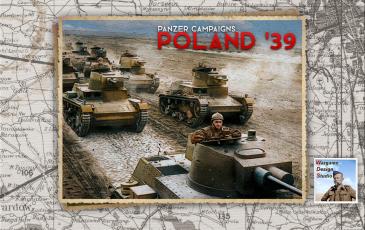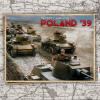0909_01b_Bzura (Complete) - Allied AI - PzC 31 Poland '39

4f09d1569063283d124d.jpg) 0 - 0 - 0
0 - 0 - 0
b59375da7db50f7a9280.jpg)
| Rating: | 0 (0) |
| Games Played: | 0 |
| SM: | 8 |
| Turns: | 102 |
| Type: | Stock |
| First Side: | Allies (Poland-39) |
| Second Side: | Axis (Poland-39) |
Date: September 9th, 1939 - Size: Large - Location: North of Lodz
Intended for play as Axis Human vs Allied AI
Scenario Briefing: Poland's forward defenses had crumbled after about a week of fighting. By September 9th, elements of the German 3rd and 4th Armies had crossed or were crossing the Narew, the Panzers of 10th Army were probing the Warsaw defenses, and the 14th Army had captured Krakow and was heading toward the San. Perhaps overconfident from their victories at the border, the Germans had lost sight of the Polish forces remaining in the Western half of the country. Largely bypassed by the initial German offensive, Tadeusz Kutrzeba's Army Poznan was still roughly at full strength, and, though Army Pomorze had suffered heavy losses defending the Polish corridor, some of its divisions had retreated across the Vistula more or less intact and excess reservists were used to reconstitute other elements. Together, the Poznan and Pomorze armies remained a formidable military force. The German command, without evidence, assumed that these remaining Polish field armies were retreating toward Warsaw. Aerial reconnaissance failed to detect Army Poznan massing near Kutno and, eager to pursue and destroy the tattered remnants of Army Lodz, the Germans took few steps to secure Army Group South's open northern flank.
General Kutrzeba had no intent of retreating. Rather, his mind was set on attack. Massing three infantry divisions and two cavalry brigade south of Kutno, Kutrzeba ordered his forces forward against the weak German flank guard late on September 9th. The ensuing action, remembered as the Battle of the Bzura, was by far the largest offensive operation carried out by Allied forces in 1939-40, and while Kutrzeba ultimately lacked the resources to roll up the German flank and repel the invader, his counterattack would sow considerable confusion in the German leadership, result in the destruction of a German infantry division, and cause considerable delay in the pace of German operations around Warsaw.
Recommended Rules: (Default)
Alternative Assault Resolution, Artillery Set Up, Recon Spotting, Virtual Supply Trucks, Optional Surrender, Low Visibility Air Effects, Quality Fatigue Modifier, Counter Battery Fire, Night Fatigue, Programmed Weather.
Additionally, Delayed Disruption Reporting will provide a more challenging experience for the attacking player.
Design Notes:
1. This larger version of the scenario covers the entirety of the Battle of the Bzura from September 9th-19th.
2. This scenario starts as draw and uses expiring objectives, appearing objectives, and exit hexes. The Polish player scores points by capturing German objective hexes before they expire and withdrawing units out of the exit hexes located on the eastern map edge. The exit hex objectives will not appear until late in the scenario. The German player can achieve a victory by holding objective hexes and capturing Polish objective hexes, some of which do not appear until midway through the scenario. The German player cannot win if he does not destroy a substantial portion of the Polish force.
3. Elements of the Lodz Army were retreating through the southeastern corner of the map on September 9th, pursued by the 10th and 17th Infantry Divisions. The retreating Polish elements have been omitted as they played no direct role in the battle. The two German divisions will start fixed at their approximate locations at the end of September 9th and will be released on the 10th. Because the 10th Infantry Division's 41st Infantry Regiment continued to pursue the Poles on the 10th, it has not been placed on the map but will arrive as reinforcements on the map edge when it was historically redirected to the Bzura.
Intended for play as Axis Human vs Allied AI
Scenario Briefing: Poland's forward defenses had crumbled after about a week of fighting. By September 9th, elements of the German 3rd and 4th Armies had crossed or were crossing the Narew, the Panzers of 10th Army were probing the Warsaw defenses, and the 14th Army had captured Krakow and was heading toward the San. Perhaps overconfident from their victories at the border, the Germans had lost sight of the Polish forces remaining in the Western half of the country. Largely bypassed by the initial German offensive, Tadeusz Kutrzeba's Army Poznan was still roughly at full strength, and, though Army Pomorze had suffered heavy losses defending the Polish corridor, some of its divisions had retreated across the Vistula more or less intact and excess reservists were used to reconstitute other elements. Together, the Poznan and Pomorze armies remained a formidable military force. The German command, without evidence, assumed that these remaining Polish field armies were retreating toward Warsaw. Aerial reconnaissance failed to detect Army Poznan massing near Kutno and, eager to pursue and destroy the tattered remnants of Army Lodz, the Germans took few steps to secure Army Group South's open northern flank.
General Kutrzeba had no intent of retreating. Rather, his mind was set on attack. Massing three infantry divisions and two cavalry brigade south of Kutno, Kutrzeba ordered his forces forward against the weak German flank guard late on September 9th. The ensuing action, remembered as the Battle of the Bzura, was by far the largest offensive operation carried out by Allied forces in 1939-40, and while Kutrzeba ultimately lacked the resources to roll up the German flank and repel the invader, his counterattack would sow considerable confusion in the German leadership, result in the destruction of a German infantry division, and cause considerable delay in the pace of German operations around Warsaw.
Recommended Rules: (Default)
Alternative Assault Resolution, Artillery Set Up, Recon Spotting, Virtual Supply Trucks, Optional Surrender, Low Visibility Air Effects, Quality Fatigue Modifier, Counter Battery Fire, Night Fatigue, Programmed Weather.
Additionally, Delayed Disruption Reporting will provide a more challenging experience for the attacking player.
Design Notes:
1. This larger version of the scenario covers the entirety of the Battle of the Bzura from September 9th-19th.
2. This scenario starts as draw and uses expiring objectives, appearing objectives, and exit hexes. The Polish player scores points by capturing German objective hexes before they expire and withdrawing units out of the exit hexes located on the eastern map edge. The exit hex objectives will not appear until late in the scenario. The German player can achieve a victory by holding objective hexes and capturing Polish objective hexes, some of which do not appear until midway through the scenario. The German player cannot win if he does not destroy a substantial portion of the Polish force.
3. Elements of the Lodz Army were retreating through the southeastern corner of the map on September 9th, pursued by the 10th and 17th Infantry Divisions. The retreating Polish elements have been omitted as they played no direct role in the battle. The two German divisions will start fixed at their approximate locations at the end of September 9th and will be released on the 10th. Because the 10th Infantry Division's 41st Infantry Regiment continued to pursue the Poles on the 10th, it has not been placed on the map but will arrive as reinforcements on the map edge when it was historically redirected to the Bzura.





















